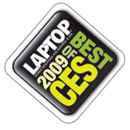Sony: VAIO P Will Make You Forget About Other Netbooks

Back in September Sony's Mike Abary told us that the company would be entering the netbook market--sort of. At the time the senior vice president of Sony Information Technology Products said "we are letting the pioneers in the market make the mistakes. Sony has to participate because consumers are our core competency. Sound like a dis to the likes of Asus, HP, and MSI? Yeah, it was. Now Sony is putting its money where its mouth is the VAIO P series, which the company hopes will transcend the netbook category. (Update: Does the VAIP P redefine netbooks? Check out our full review to find out.) And it had better for $899. We sat down with Abary before CES to ask him about the genesis for the P series, its target audience, the importance of integrated GPS and mobile broadband, and more. Here's the quick highlights:
- Sony does not consider the VAIO P series to be a netbook. In fact, Abary told us that "the type of premium customer they are targeting "probably doesn’t even know what a netbook is."
- Abary estimates that as much as 60 percent of perspective VAIO P buyers is women.
- Sony is leaving the option open for pricing models that could include subsidized pricing if you purchased the VAIO P through a carrier.
- The company doesn't see cheap 12-inch notebooks as a threat. In fact, Abary questions whether netbooks are getting too big for their own good.
It seems obvious that Sony is trying to steer away from the netbook category with the VAIO P series. How are you defining it? We are defining it as a different category of product. It is based on the evolution of VAIO’s ultraportable category, rather than anything else that is happening in the marketplace. This is our evolution of what we see as the next amazing VAIO product. The last ultraportable we did was the VAIO UX and it has been awhile since we have done something new and amazing in the category. Loyal VAIO owners come to expect that from us. We are not responding to the netbook phenomenon. But at the end of the day consumers are going to compare the P Series with lower cost netbooks. What is Sony’s positioning of this product in the marketplace? Contrary to how we have designed and built products in years past we designed this product from the ground up with a particular consumer in mind. That is a huge difference. The consumer drove all the decisions that we made. That consumer is more interested in style and design and very interested in form factor and mobility. It is skewed more female than male. And, quite frankly, there is less emphasis on speeds and feeds and more emphasis on how this product is going to make you look and feel. That type of customer probably doesn’t even know what a netbook is. The customer we are targeting is probably not going to do product comparisons; they are going to look at this product and say “that is unbelievable.” Given that, what features or design elements does Sony point to as being worth the premium? A couple of those things are strictly in the design. We designed the product around the keyboard and having it stretched to the outer peripheries. The decent typing experience is one differentiator for sure. The second is the LCD; it is a very high resolution 8 inch LED with a 1600 x 768 resolution. The reason we did this was we wanted to mirror and replicate the experience they have at home on their primary PC. How do you avoid an unpleasant viewing experience with smaller icons and text? We feel that customers will primarily use this PC for Web browsing. With Web browsing we eliminate the side-to-side scrolling that you have on other similarly sized ultraportables. But we also have a function key (F10) for magnifying, which increases the size of font and of items but doesn’t change the resolution. It actually uses the function keys in each of the programs. For example, in Internet Explorer it will zoom as if you went into the menu and selected zoom. If you are on the Windows desktop it will also zoom the icons. In Vista you can also adjust the font size throughout the whole operating system. The VAIO P Series seems to have a heavy emphasis on style and fashion. What do you see as the male-female split among buyers for this product? Our current VAIO sales data has a healthy amount of females and typically technology products are more popular with men. With VAIO we actually buck that trend. The same thing can be said with this lifestyle P Series. So we think it will be a 60/40 split. Why are you offering mobile broadband only through Verizon Wireless? It will incorporate Gobi, but we have decided not to fully utilize the opportunities of Gobi right now, including using any carrier. We are using one carrier right now and that is Verizon. However, the worldwide capability is something we are working on implementing in the future. A few weeks ago Acer announced a subsidized Aspire one, where you can pick up the netbook for $99 with a 2-year AT&T contract. Would Sony consider a similar move? What Acer has done has really set a precedent for the possibilities of combining embedded cellular in PC devices. My opinion is that thatprecedent is quite impactful, and I do believe there will be opportunities moving forward that will expand that. We are not offering any subsidy options at this time but we are leaving that option open. Do you think having GPS integrated will help the VAIO P stand out? Why not offer voice-guided directi0ns out of the box? Previously when we had Sprint you had to acquire WWAN in order to use GPS functionality. Now we don’t have to take advantage of the WWAN service to get a GPS lock. We included Microsoft Streets & Trips 2009 with every notebook so there is a full GPS solution right out of the box. There is no voice guided assistance, but in order to do that we had to look at other providers and that would have been a lot of data installed on each unit. It could have been as much as 8GB with those options so we went with this because it’s not as taxing. Of course, you can go out and get Garmin software etc. Vista has sort of become a naughty word, in this market segment. How do you overcome the negative stigma of that OS? We actually consider Vista a differentiator compared to other devices this size. We wanted to mirror the experience people had on their PC at home on this companion device. We are using Vista as a selling point, which I think that is kind of unique. Sony has been called out in the past for pre-loading too much trial software. Have you been more mindful of that issue on this smaller device? We are laser focused on the customer experience. We are not just mindful but we have an entire team dedicated to the improvement experience, and one of the top priorities is boot up and clean install. We have eliminated a gigantic portion of what you would typically experience with a full size version of VAIO from consumer retail versus what you would experience with the P Series. The reason why is because the architecture and processor we are using does have some limitations, and we want to make sure we don’t weigh the performance down. We are also using an instant mode ,which is a Linux application that uses our Media Bar. It boots into the system in 20 seconds. Would you say the VAIO P is upgrade friendly? There is a physical limitation on configurability. It is a fully encased product, meaning there are no exposed screws at all. It ensures security of the product but on the flip side it doesn’t allow for upgradability. It is really hard to upgrade or swap out components. The motherboard is the size of a mini-disk and everything is really soddered and fixed. There are three configurations though that we are offering and the variation is hard drive type and size. We are seeing a lot of notebook vendors offering low cost 12-inch notebooks with either Intel Atom processors or AMD Neo. Do you see that emerging category as a challenge? I am not sure if the same customer that was interested in a netbook is interested in something bigger. With our platform we have an end user in mind and it isn’t necessarily mainstream. But these netbook manufacturers seem to be confusing the market place with this whole evolution. We aren’t about throwing technology out there and seeing what it sticks.

The VAIO P is the Best Netbook of 2009 CES!
Stay in the know with Laptop Mag
Get our in-depth reviews, helpful tips, great deals, and the biggest news stories delivered to your inbox.

